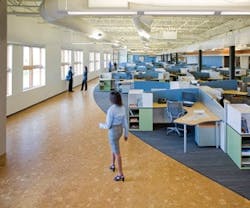Meshing Green Design with Acoustics
Green buildings do many things well – but noise control and speech privacy can’t always be counted as part of that list. Some of the strategies that make green buildings green result in poor acoustics. Post-occupancy evaluations studied by the Center for the Built Environment at University of California Berkeley offer proof. “Relative to acoustics, people’s satisfaction was actually slightly lower in green buildings than in regular buildings,” says Ken Roy, senior research scientist and acoustician at Armstrong World Industries.
Not only are acoustics often ignored when creating a green building, but they’re also ignored by the organizations defining green buildings. According to Niklas Moeller, vice president of KR Moeller Associates, “Some of the prominent green building rating systems, such as LEED, have excluded credits for anything acoustical. At best, they’ve offered it up as an optional credit.” That may be changing, though: Efforts to include acoustical credits in LEED for Schools and LEED for Healthcare are promising.
Problem: Daylighting
As Professor Ralph T. Muehleisen of the Illinois Institute of Technology in Chicago explained in the January 2010 InformeDesign newsletter, glass has low sound isolation capabilities. Windows let in street noise, and interior glass partitions don’t always absorb sound well.
Even the shape of a daylit building can be detrimental. “The geometry of the space tends to be longer and narrower to ensure that no spot is too far from a window. But long, narrow spaces provide a bowling alley effect for sound because it bounces between exterior walls,” explains Moeller.
Accommodating daylighting can cut down on speech privacy as well. “Private offices are moving away from the perimeter to allow for daylight harvesting. This creates an increase in conversations surrounding the private office and the potential for confidential conversations to be overheard,” says Brian Riley, president of Margenau Associates. Taller panels create a barrier between occupants, absorbing and blocking sound.
Problem: Natural Ventilation
Operable windows let in exterior background noise, especially in urban settings. To prevent airflow from being restricted in buildings with natural ventilation, the interior is designed with as few barriers as possible, which limits speech privacy.
Problem: Underfloor Air Distribution
Underfloor air distribution decreases background sound levels. The white noise of conventional HVAC systems helps mask conversations. “These systems are much quieter than traditional ducted systems, allowing conversations to carry farther through the workspace,” explains Riley.
Problem: Active/Passive Heating and Cooling Systems
Nontraditional heating and cooling, such as radiant floor heating or thermal mass, requires exposed concrete surfaces. Using thermal slabs eliminates the sound-deadening capabilities of carpet and the absorption that acoustical ceiling tile provides.
Problem: Use of Hard Surfaces
In green buildings, harder materials are often used because they’re easy to maintain and offer a longer lifespan, explains Moeller. Unless designed with acoustics in mind, spaces without sound-absorbing finishes suffer from reverberation, echo, and elevated noise levels.
Solutions
It’s never too early to think about acoustics. Understand the acoustical ramifications for green design decisions, be aware of tradeoffs, and seek compromises. Consider strategies and products to balance the negative acoustics that result from green strategies.
- Strike a balance between the glass required for daylighting and the solid-wall construction that provides comfortable acoustics.
-
Use acoustic baffles and full-height walls with acoustic louvers in naturally ventilated buildings.
-
When underfloor air distribution lowers background sound, use soundmasking.
Follow published guidelines. Spend time with the FGI Guidelines for the Design and Construction of Health Care Facilities; its acoustic recommendations are the basis for the acoustic requirements in LEED for Healthcare. If your next project is a school, study ANSI Standard S12.50.
According to Anita Snader, sustainability manager at Armstrong World Industries, there are software programs designed to improve acoustics. These programs can even predict the acoustics of spaces before construction begins.
Seek green acoustical products. “There are solutions that provide recycled content, recyclability, low VOC emissions, etc.,” says Snader. “In addition, you get an acoustical treatment.”
Don’t let value engineering kill acoustics. “Attempts to reduce costs can have a minimal impact on initial price and a large impact on lifetime performance,” warns Riley.
Jana J. Madsen is a Cedar Rapids, IA-based freelance writer.
